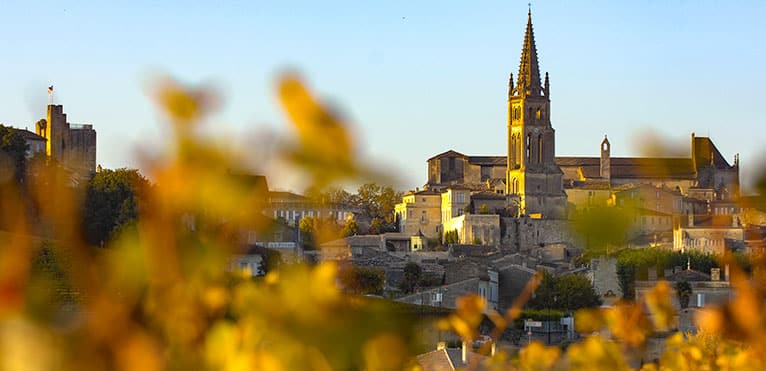
Contents
Fronsac is a Bordeaux appellation that produces red wines and is unique in having a sister appellation: Canon Fronsac. Fronsac was awarded the AOC and AOP (Appellation d’Origine Protégée) labels in 1937.
Fronsac, a tale of twins
The history of Fronsac cannot be dissociated from that of its sister appellation, Canon Fronsac. After the long period of Roman occupation that marked the launch of Bordeaux winegrowing, Charlemagne built a castrum in 769. These were in fact the beginnings of the fortified town of Fronsac, whose economy was based on its vineyards. The Duke of Richelieu decided to build a sumptuous residence here, helping to establish the appellation. The latter was very popular with the nobility, so much so that by the 18th century, she and her sister had an excellent reputation throughout the country.
Today, Fronsac has a major international reputation, and its rarity on world markets makes it an exceptional appellation.
The vineyards of AOC Fronsac are nestled between two rivers
The Fronsac vineyard lies at a very low altitude, around 50 to 40 meters, in the heart of the Libourne vineyards. The plots are perched on the steepest slopes of charming hillsides, sandwiched between the Dordogne and its tributary the Isle. Two types of soil can be distinguished. Firstly, the limestone and clay-limestone soils underlain by the molasse of the Fronsadais region are soft enough to encourage the vine’s roots to flourish.
This blossoming is constrained by the shallowness of this type of soil, offering the perfect compromise between good yields and the development of interesting aromas. Then, below, some plots are on alluvial soils, rich in minerals. Thanks to their porosity, these rocks are essential for good vine drainage. They prevent water stagnation and are a source of minerals.
In addition, the climatic conditions enjoyed by the Fronsac plots are conducive to good vine development. The climate is oceanic and temperate, typical of the Aquitaine region. Moreover, nestled between the Dordogne and Isle rivers, the vines are protected from frosts as the rivers regulate the temperature.
Fronsac is a wine for laying down
Fronsac is a blended red wine, meaning that its Charter allows for the use of several grape varieties in its conception. Nevertheless, its charter requires the use of a minimum of 85% Merlot, which is therefore the dominant grape variety. Smaller proportions of Cabernet Franc and Cabernet Sauvignon are also found. These three grape varieties are renowned for their character, but are accessible to novice tasters.
To the eye, Fronsac has a deep garnet-red color and, in its youth, delicate violet reflections. On the nose, it reveals aromas inherent to Bordeaux red wines. It reveals strong primary notes of red and black fruits such as cherries, redcurrants and plums. These aromas are associated with Merlot and Cabernet Sauvignon.
The finest noses will recognize, after aeration, tertiary aromas of vanilla, chocolate and even mocha. These are linked to fermentation. On the palate, Fronsac stands out for its direct, dense attack. If the tannins revealed by a young Fronsac are firm, they become more refined with age.
In this respect, we generally recommend keeping a bottle of Fronsac for at least 5 years. Over time, the diversity of the Libourne terroir can be felt in the aromas.
Fronsac is an ideal wine for red meats
Fronsac is a dry still wine. Like many Bordeaux red wines, Fronsac is ideal for red meats, legs of lamb and small game, as well as white meats, especially poultry. For example, pair it with tournedos Rossini, quail stuffed with mushrooms, black pudding or black Angus beef. When it comes to cheese, the aromatic power of Fronsac will sublimate even the strongest cheeses, provided they are dry, such as Rocher Nantais or Boulette d’Avesnes.
Fronsac is generally served at between 16 and 17 degrees. For optimal tasting, we recommend decanting.
The 1980s, impossible to go wrong
Fronsac can benefit from several designations, such as “Vin de Bordeaux” or “Grand Vin de Bordeaux”. The 1980s were rich in excellent vintages. Indeed, 1983, 1985, 1986 and 1989 were remarkable years. In fact, 1982 was named “vintage of the century”. Of all the years, 1945 is the best with the “millennium vintage” label.
Two of the few châteaux in the Blayais region
Château Villars
For seven generations now, the Château Villars estate has been in the hands of the Gaudrie family. Despite the trials and tribulations of the 19th century, such as mildew and phylloxera, the estate has always maintained its high standards. As a result, it produces Fronsac wines that are recognized far beyond France’s borders.
Over the last century, the estate has grown to double its size. It now covers 40 hectares, 30 of which are reserved for vines. The rest of the estate is given over to woods and meadows which, in symbiosis, improve the quality of the soil.
In fact, the Gaudrie family is firmly committed to the values of high standards and quality for its customers. This commitment includes extensive oenological training, as well as a return to traditional viticulture.
Château de la Dauphine
Built in 1750 by Maître de Richon, a renowned lawyer, Château de la Dauphine takes its name from an astonishing anecdote. Indeed, just after it was built, the Dauphine of France, Madame de Saxe, spent some time here, giving her name to the estate.
This Fronsac wine estate then passed into the hands of several families who, recognizing the exceptional terroir, launched and developed viticulture. In 2015, the estate was bought by the Labrune family, who gave it a new direction. Concerned about preserving the environment, they converted the 53-hectare estate to biodynamic viticulture.